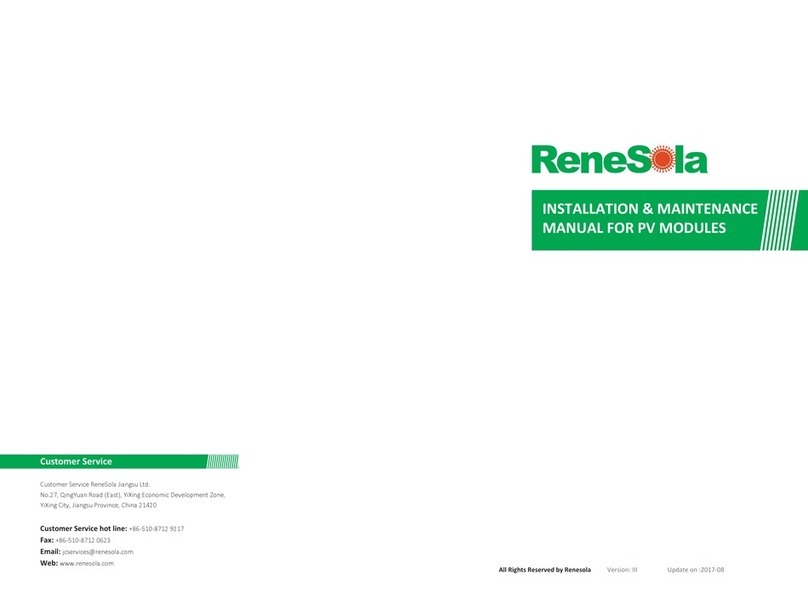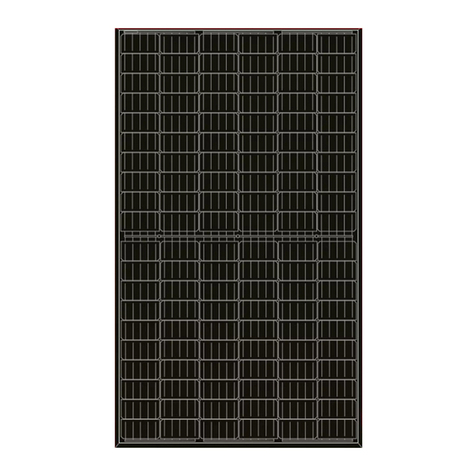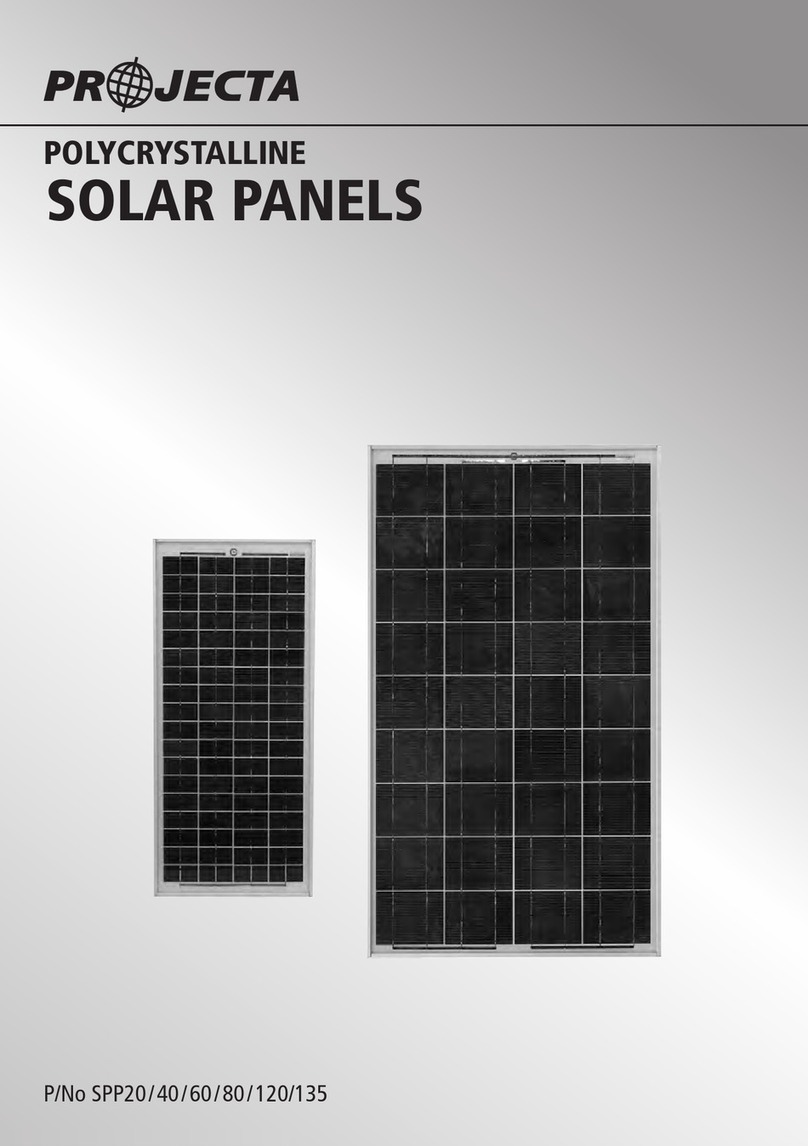Energie Solar Block 4 Guide

CentralHeating
SwimmingPoolHeating
HighVolumeHotWater
InstallationandUseManualfor
SolarBlocks4to40
Eco500to6000
ROV3

1
EUROPEAN CERTIFICATION
EN60335‐1
EN60335‐2‐21
Directives:
73/23/CEE93/68/CEE
Congratulations on your excellent choice in acquiring a system that will reduce your
energy consumption and benefit the environment.
Please read the manual carefully before installing your thermodynamic solar system.
This manual does not intend to replace, in any way, the thermodynamic solar systems
installation course.
ATTENTION
The use of a power circuit with inadequate voltage and frequency will result in the
damage of the unit and potentially cause a fire incident.
Pulling the power cable may cause damage or electric shock. Don't use the power
cable incorrectly.
Always use a fuse with the proper amperage.
As for the feeding cables, please comply with the local rules and regulations. The
improper connection may result in the overheating of the feeding cable, the connector
or the electric socket and cause a fire.
For your safety, turn off the circuit breaker or disconnect the power cable when you do
not intend to use the equipment for a long period of time.
In case the cable needs replacement, use only the network power cable specified by
the manufacturer.
Any and all intervention should be performed by a certified technician.
Any repairing or maintenance operation that is not performed by a certified technician
will result in the loss of warranty.

2
Contents
1.0Functioning……………………..……………………………………………………………………………………………………3
1.1TechnicalSpecifications…………………………………………………………………………………………………………4
2.0Systemcomponents.……………………………………………………………………………………………………………4
2.1ThermodynamicBlock…………………………………………………………………………………………….…….........5
2.2SolarPanel………..........…………………..………………………………………………………………………….……......5
2.3FluidDistributor.....………………………………………………………………………………………………………………..5
2.4Fluid………………………………………………………………………………………………………………………………………6
2.5Tubing....................................................……………………………….………..........................................6
3.0PanelInstallation..……………………………………………………………………………………………………………….6
3.1MaximumDistance……………………………………..………..………….....................……………………………...6
3.2Unevenness…………………………………………………...........................................................................7
3.3SolarPanelsOrientation........................……………………………………………......................................7
3.4TiltAngle...............………………………………………………………………………………………………………………...7
3.5TypeofThermodynamicSolarPanels...…………………………………………………………………………………8
3.6StandardDistancebetweenthePanels....……………………………………………...................................8
3.7PanelLayout……………….………………………….............…………………………………………………………………9
3.8SolarPanelFixing……………………………………………………………………………………………………………………10
4.0ThermodynamicBlockInstallation…………………………………….………....….........…………………………10
4.1ChoiceofLocation..........................................................………………………………………………………..10
5.0ConnectionbetweenthePanelsandtheThermodynamicBlock………………………………………….11
5.1Welding………….………………………………......................................................…………………………………11
5.2DistributorsandCollector'sConnectiontothePanel's Tubing………………………………………………12
5.3Suctioncollector..................................……………………………………………………………………………………12
5.4ConnectionstotheThermodynamicBlock......……………………………………....................................13
6.0HydraulicConnections.............................……………………………….................................................13
7.0FluidLoad..................………………..………………………………………………………………………………………...14
7.1Leak‐tightnessTesting……………………………………......................……….…………………………..…………...14
7.2Vacuum......................................................................................………..…………………………………...14
7.3LoadofR407c...............................................………......…………………………………………………..………..14
8.0ControlPanel......................................................................…………………………………………………...16
9.0ElectricalWiring...........................…………………………………………………………….……………………........16
10.0Troubleshooting..................………………………………………………………………………….…………………..18
11.0InstallationSchemes…………………………………………………………………..........................................
Guarantee…………………………………………………………………………………………………………………………………….
21
30

3
1.0Functioning
TheENERGIEsolarsystemsarethermodynamicsolarsystems.
Thesolarpanellocatedoutsideensuresthecaptureofenergythrough:
oDirectanddiffuseradiation
oExteriorairbynaturalconvection
oWindeffect(usuallypresent)
oRainwater
Thetemperaturegradientcausedbytheabovefactorsensuresthatthefluidpassestothe
gaseousstateinsidethepanel.
Thecompressorextractsthecoolingfluid(vapour)fromthepanelbyrisingitspressureand
temperature,whichisthentransmittedtothewatercircuitthroughaheatexchanger.
Theexchangerisplacedinsidethecabinet(ThermodynamicBlock)providingheattothewater
ithasinside.
Whenthecoolantreachestheexpansionvalveitisintheliquidphase,andthelossofloaddue
tostrangulationreducesthepressure,whichleavesthefluidreadytore‐enterthepanels.
Sun
Wind
Rain
ThermodynamicGroup
Solar
Panels

4
1.1TechnicalSpecifications
TheSolarBlocksandtheEcomodelsforhighvolumewaterheating(HVWH)ENERGIEareon
themarketinarangewith4,6,8,12,16,24,32or40solarpanelsaccordingtothefollowing:
CentralHeating/SwimmingPoolHeating
ModelNrofPanelsAbsorbedPowerSuppliedPowerFlow(m3/h)
SolarBlock44960W7,290W0.5
SolarBlock661,230W9,680W0.7
SolarBlock681,440W11,240W0.8
SolarBlock12122,010W16,580W1.0
SolarBlock16163,210W24,210W1.5
SolarBlock24244,140W31,430W2.8
SolarBlock32325,690W42,600W4
SolarBlock40407,630W52,970W5
HVWH
Model
Capacity
(L)
NrofPanels
Dim.HotWaterCylinderAbsorbed
Power
Thermal
Power
Height
(mm)Diameter(mm)
ECO50050021830650595W2,800W
ECO75075042135750960W7,290W
ECO1000100042185850960W7,290W
ECO15001500624609501,230W9,680W
ECO200020008252011001,440W11,240W
ECO3000300012290012502,010W16,580W
ECO3000E300016290012503,210W24,210W
ECO4000400024296014504,140W31,430W
ECO5000500032303016005,690W42,600W
ECO60006000402x29002x12507,630W52,970W
2.0SystemComponents
TheThermodynamicSolarSystemsarecomposedbythefollowingelements:
oThermodynamicBlock
oThermodynamicSolarPanels
oLiquidDistributor

5
2.1ThermodynamicBlock
TheThermodynamicBlockiscomposedofseveralelementssuchas:
oCabinet
oHermeticcompressorScrolltype
oHeatexchanger*
oExpansionvalve
oOilseparator
oFluidtank
oFilter
oFluiddisplay
oPressuregauge
oDigitalthermostat
oElectricalequipment
*‐titaniumheatexchangersgoapartfromthethermodynamicblock.
2.2SolarPanel
Thesolarpanelismadeofanodized
aluminiumofdualrailwithpostpressing
anodicoxidationforhighsolarabsorption.
Thedimensionsofthepanelare2000mmx
800mmx20mm,anditfeaturesafluidflux
inandoutmadeofacopper/aluminiumtube
withinnerdiameterof¼’’.Itweights
approximately8kg.
Whiletransportingthecollectorprotectedit
againstimpactandmechanicalactions,thereforeproperpackagingupontransportationis
recommended.
2.3FluidDistributor
Toensurethatthefluidreachesthepanelin
aseamlessmanner,it'snecessarytoinstalla
fluiddistributor.Thisdistributorfeaturesas
manydistributiontubesasthenumberof
panelsintheinstallation.
Thedistributorisplacedbetweenthepanels.
Theconnectiontubestothepanelsmust
havetheexactsamelengthanditsendsare
directlyconnectedtothepanels.
Dimensions[mm]ABC
ThermodynamicBlockfrom4to16panels880630430
ThermodynamicBlockfrom24to40panels880750500
SolarPanel
Serpentinedetail

6
2.4Fluid
TheR407cisazeotropicmixture(afluidwithmorethanonecomponent).Itischemically
stable,possessesgoodthermodynamicproprietiesanditpresentsitselfasacoolantwithlow
impactontheenvironmentandreducedtoxicity.
2.5Tubing
Itisessentialthatthetubinghavecoolingqualities,bothinthesuctionandinthefluidline
(feeding).Itisalsorecommendableforallthetubingtohaveahighqualitythermalisolationto
avoidpotentialcondensation.
Thetubingdiametervariesaccordingtothesystemmodel,asshownonthefollowingtable.
TubingDimensions
ModelSuctionLineFluidLine
SolarBlock4/Eco750/Eco10005/8’’1/2’’
SolarBlock6/Eco15003/4’’1/2’’
SolarBlock8/Eco2003/4’’1/2’’
SolarBlock12/Eco30007/8’’1/2’’
SolarBlock16/Eco1500 7/8’’3/4’’
SolarBlock24/Eco40001’’1/83/4’’
SolarBlock32/Eco50001’’1/87/8’’
SolarBlock40/Eco60001’’3/87/8’’
3.0PanelInstallation
3.1Maximumdistance
Themaximumdistancebetween
panelsandtheThermodynamicBlock
is20meters,howeverifshouldthere
beabiggerdistancetheeventual
lossesgeneratedbythelengthofthe
tubingcanbereducedwiththecorrect
calculationofthethermalisolation
usedandbyadjustingthetubes
diameters.
FluidR407c
MolecularMassKg/Kmol86.2
Boilingtemperatureat1.013barºC ‐43.28
CriticaltemperatureºC86.2
Latentheatuponevaporationat25ºCkJ/kg250
Criticalpressurebar54.5
Fireresistant
Max.H=15

7
3.2Unevenness
Innormalsituationsthemaximumunevennessshouldalwaysbelessthan15meters.
However,therearesituationswhereitisnotpossibletorespectthatmeasurement.Insuch
casesyoupleasecontactourtechnicaldepartment.
Thesuctiontubingandthedistributionrodsshouldriseabovethepanellevel,inordertoavoid
theeffectofquicksiphonofthefluidwhenthecompressorstops.
3.3SolarPanelsOrientation
TheENERGIEsolarpanelsshallbe,
preferablyorientedtowardsSouth,but
theycanalsohaveadislocated
orientationtoNortheastorNorthwest.
3.4TiltAngle
Thetiltingangleofthesun
beamsinrelationtothe
horizontalpositiondependson
theseason.Inthewinter,in
Zenith,thesunbeamshavean
angleof20ºto40ºinrelationto
thehorizon.Inthesummer,the
angleisbetween60ºand80º.
Tobenefitthemostfromthesunbeamsitispreferabletochooseatiltbetween45ºand90º.
Youmayhoweverinstallthepanelswithadifferenttiltincertainsituations.
North
WestEast
SouthOptimalOrientation
OrientationLimits
Bad
Good
Summer
Winter
Horizont
Zenith

8
3.5TypeofThermodynamicSolarPanels
Therearetwotypesofpanels:
oLeftSolarPanels
oRightSolarPanels
Thedirectionofthepanelsisdefinedbythedownwardtubingexitsandbytheviewofthe
frontpartofthepanels.Theyshouldalwaysbeplacedwithalongerhorizontallengthandthe
connectionsfacingdown.
Left:Aleftpanelisinstalledontheright(frontview);forthatpurposeitsconnectionsareon
theleftside.
Right:Arightpanelisinstalledontheleft(frontview),forthatpurposeitsconnectionsareon
therightside.
3.6StandardDistancebetweenSolarPanels
Thepositionofthepanelsandthechoiceoftheconnectionsidesshallbedonesuchastolimit
thelengthofthetubingandsimplifytheconnections.
Asforthedistancebetweenthepanels,itischoseninordertofacilitateitsplacementandthe
connectionbetweenthetubing.
‐Minimumspacebetweenpanelsontheconnectionsside:200mm(idealspacing:500mm)
‐ Spacingbetweenthepanelsontheoppositesideoftheconnections:theyshouldnotbein
contactwithoneanother(preferably>10mm)
SteamLine(Out)
LiquidLine(In)
SteamLine(Out)
LiquidLine(In)

9
3.7PanelLayout
TherelativePositionofthepanelsdependsonwhichsystemisinstalled,ontheavailable
installationarea,onthearchitectonicintegration,amongothervariablesthatmayhavelocal
impact.
Someofthepossiblelayoutsforthepanelsarerepresentedinthefollowingscheme.The
installationtechnicianmayoptforadifferentlayoutaslongasitcomplieswithalltherelevant
criteriaforanadequateinstallation.
SolarBlock4orEco750/1000
a)b)
SolarBlock6orEco1500
a) b)
SolarBlock12orEco3000
a)
b)
ENERGIEENERGIE
ENERGIE ENERGIE
ENERGIE
ENERGIE
ENERGIE
ENERGIE
ENERGIE
ENERGIEENERGIEENERGIE
ENERGIE ENERGIE
ENERGIE ENERGIEENERGIE ENERGIE ENERGIEENERGIE
ENERGIE
ENERGIE
ENERGIE
ENERGIE ENERGIEENERGIE
ENERGIE ENERGIE
ENERGIE ENERGIE
ENERGIE ENERGIE
ENERGIE
ENERGIE ENERGIEENERGIE
ENERGIE ENERGIE ENERGIEENERGIE
ENERGIE ENERGIEENERGIE
ENERGIE

10
3.8SolarPanelsFixing
Thefixingofthepanelsdependsontheinstallationsite.Themethodandtypeoffixing
dependsentirelyontheinstaller'sdecision.Thereare,however,severalfactorsthatshouldbe
takenintoconsideration(previouslydescribed,suchasthedistanceandtheorientation)for
thecorrectpanelsfixing.Asforthephysicalpartofthefixingstands,theyshouldhavea
resistantstructureaccordingtothecircumstancesofthesite.Eachandeverypanelmustbe
fixedin6points(atleast).
Thefollowingpictureisanexampleofthefixingused.The
fixingofthepanelsisensuredbyaluminiumstands.
Thestandisfoldedintoan"L"shapewithtwoM8bushing
holes.Thestandbaseisfixedtotheroof(ifthatisthe
case)withaM6screwandaplasticsleeveorbya
threadedfemale(dependingonthesituation).
TheotherharmofthestandisfixedwithgalvanizedM6
screwstopreventcorrosion.
NOTE:Thepanelsshouldhaveaminimum
spacingof50cm(inrelationtothepreviousand/ornextpanel)
4.0ThermodynamicBlockInstallation
4.1ChoiceofLocation
Thechoiceofthelocationwherethethermodynamicblockisgoingtobeplacedhasamajor
importance,andshouldbechosentakingintoconsiderationacertainnumberofimportant
criteria,suchas:
oAccessibility
o(incaseofreplacement)
oPossibilityofvibrationtransmission
oPositionofthetubingcomingoutofthepanels
Itisessentialthatthethermodynamicblockstaysinadryventilatedplace
protectedfromallweatherconditions.
Thelocationshouldbechosensoastofacilitatethesettingandconnectionofalltubes,and
itshouldalsoalloweasyaccesstomaintenanceoperations.
Note:Avoidinstallingthethermodynamicblocknearbedroomssincetheymaytransmit
vibrationand/ornoise.
Itmaybeplacedinthefloororonacantilevered(upagainstawall).
Youshouldplaceanti‐vibratingstandsbetweeneachapplianceandthefloor.
Inthecaseitiscantilevered,itshouldbefixedtothegroundandtothewall,andseparatedby
anti‐vibratingstandsbetweenthecabinetandthewalls.Ifyouputtheblockintheatticyou
shouldpayspecialattentiontothevibrationstransmittedtothebuilding(madeofwood).You

11
shallalsoplaceatrayunderneaththeappliancesoitmayretrievewaterincaseofapotential
leakageontheequipment.
Duringtransportandinstallationneverholdormanipulatethethermodynamic
blockbytheit’stubes.
5.0ConnectionbetweenthePanelsandtheThermodynamicBlock
Whentheinstallationofthesolarpanelsandthethermodynamicblockiscompletedthenext
stepisinstallingtwotubingconnections:
oFluidTubing(feeding)
oSuctionCollector
Beforeyouperformtheabovementionedconnectionsitisadvisabletoexecutethe
connectionsofthetubesofthepanelstothe:
oLiquiddistributor(s)
oSuctioncollector(s)
Establishingtheconnectionsisoneofthemostdelicatestepsofthewholeinstallationanditis
veryimportantthattheweldingisdoneaccordingtoallkeycriteriaforaqualitywelding
process.
5.1Welding
Thetypeofweldingrecommendedforperformingthetubingconnectionistheoxy‐acetylene
welding(oxygen/acetylene).Anothertypeofgasmaybeused,like,forinstance,propane.
Theconnectiontubingisweldedtotheinandoutwithasilverrod(at40%).Before
startingtheweldingprocess,youshouldperformsomepreventiveactionssothat
the"retractilejoint"isnotdamaged.
Withapieceofdampclothyoushouldenvelopthe"retractile
joint"sothatitisproperlyprotectedfromthehightemperatures
causedbytheweldingflame,asitisshowninthefollowing
picture.
Nowheatupthemetal:thecopper,untilitbecomesdarkred.
Drawtheweldingrodcloser,slightlytilted,withoutexposingitto
theflame.Generally,theamounttoapplyequalsoneandhalf
timesthediameterofthetube.Assoonasthealloyexpands,
stopheatingandletitcooldown.Removethesurplus.
Whentheweldingiscompletedandafterensuringthatitisnolongerintheliquidstate,you
shouldquicklycooldowntheentiresurroundingareaoftheweldingwithawetcloth.
Theweldingnearthethermodynamicblockshouldalsobedonewithasilverrodandattention
shouldbegivensoasnottoburnanycomponentoftheblock.
Afteralloperationsarecompleted,thesystemisreadytoperformaleaktightnessproofand
alltheloadprocessofcoolant.

12
5.2DistributorsandCollector'sConnectiontothePanel'sTubing
Forconveniencereason,theplacementofthedistributorandthecollectormaybedoneprior
totheinstallationofthepanels(nuisance,passageofthetubingbehindthepanels)
Removetheprotectionlidsofthetubingonlywhenyouconnectthefeedingandthesuction
rodstopreventtheentranceofimpurities.
Installthedistributor(s)verticallyheaddown(neverhorizontally!)thusensuringthatthefluid
getstothepanelshomogeneously.
ENERGIEENERGIE
ENERGIEENERGIE
ENERGIEENERGIE
ENERGIE ENERGIE
Linha de Líquido
Lira Principal
Cu 1/2"
Itisimperativethatallfeedingrods(
∅
1/4’’)havethesamelength.Thesame
appliestotherodsofthemaindistributor.
Ifoneoftherodsistoolongforthelengthitneedstocover,youshouldrollitupandnevercut
it.Shouldyouwanttoshortenorextendaroditisalwaysnecessarytoperformthisprocess
onalltherodswiththesamediameter.
Alloftherodswith∅1/4’’mustbeweldedtothelowerconnectionsofthepanels(fluidin).
Therodswith∅1/2’’ofthemaindistributormustbeweldedtothesecondarydistributors.
5.3Suctioncollector
AccordingtotheThermodynamicBlock'smodelandthepositionofthepanels,itisnecessary
tomakeoneormoreSuctioncollectors.
Thesuctioncollectorthatenablesretrievingthecoolantinthegaseousstatemustregroupall
suctionexits(∅3/8’’)fromthepanelstothecollector.
Allrodsshallbeweldedtothetopexitsofthepanels.
Itisimportantthattheconnectionsinthecollectorsareassimpleaspossibleandthatthe
instructionsarefollowedincasethereisaramp.
ENERGIEENERGIE
ENERGIE ENERGIE
ENERGIEENERGIE
ENERGIEENERGIE
Cu 5/8"
Cu 5/8"
Cu 3/4"
Linha de Aspiração
Liquid Line
Suctionline

13
5.4ConnectionstotheThermodynamicBlock
Thethermodynamicblockhasseveraldifferentconnectionsas
describedbelow.
Theconnectionsofthethermodynamicblock(cabinet)tothe
panelsaredulysealedsoastoavoidtheentranceofimpurities
inthecoolingcircuitandtoprovideinsulationfromthe
humidity.
Beforeproceedingwiththepanelsconnectionsitisnecessarytoemptythenitrogen
loadthroughtheloadpipe(allequipmentleavesthefactorywithanitrogenloadat
30bar).
6.0HydraulicConnections
Theconnectionofthethermodynamicblock(cabinet)totheheatingcircuitisdoneaccording
tothetypeofinstallation:
oNewstructure
oExistingstructure(whenreplacinganothersystem)
Incaseofanewstructure,thelayoutofthewatercircuitmustbecarefullystudied,takinginto
considerationthebestlocationfortheblock(cabinet).Incaseofanexistingstructure,the
thermodynamicblockmust,imperatively,beplacedinparallelwiththeothersystem(ifthatis
thecase)andchoosethebestplacetoinstalltheBlockstudied,whilerespectingtheexisting
watercircuit.
Itismandatorytoapplyananticorrosionadditive(stabilizingfluid)tothehydraulic
circuittopreventclogging,electrolyzephenomenaandnoiseinthecircuit.
First,preferablychooseheatemittersoflargeexchangesurface(under‐floor
heating,radiators,convectors,fanconvectors),sincetheyenabledistributionatlow
temperatureandachievebetterperformances.
Thecirculationpumpmustbeplacedtakingintoaccounttheloadlostandtheminimumflow
ofthecondenser(heatexchanger).Thenexttablepresentstheminimumflowforeachofthe
systems:
SolarBlock 4681216243240
Minimumwaterflowinthecondenser(m3/h)0.50.70.81.01.52.845
NrDescription
1SuctionLine
2FluidLine
3ConnectiontotheHeatExchanger(DHW/SwimmingPool)
4Exit(watercircuit)
5Return(watercircuit)
6ElectricalWiring

14
7.0Fluidload
7.1Leak‐tightnessTesting
Aloadofnitrogenatapressureof12bar(max.15bar)willbeoptimaltoensurethatthereare
noleaksinthewelding.Whentheequipmentisdulycharged,envelopalltheweldingwith
soapfoamandchecktheexistenceofnitrogenleaks.
Thepanelsshouldbe2to3dayswithaloadofnitrogentoensureinexistenceofleaks.Once
thisoperationiscompleted,removeallnitrogenfromtheequipment.
7.2Vacuum
Beforeloadingthecoolant,youmustcreatevacuumintheequipment.Thepurpose
ofvacuumisremovingallairandhumiditypresentinthecircuit.Theamountof
vacuumtimedependsonthefollowingfactors:
oVolumeofthevacuumpumpinm3/h
oVolumeofthetubes
oVolumeofthesystem
oAmountofwaterinthesystem
Thisoperationisdonefromtwoloadpipes,placed,oneinthesuctionline(nearthe
compressor)andtheotherinthefluidline.
Oncethevacuumprocessisover,closethefaucetsofthevacuumpump.Thevacuumgauge
shouldalwayspresentthesamereadingafterstoppingthepump,thusensuringthatthe
equipmentmaintainsthevacuumandisreadyforthecoolantload.
SolarBlock4681216243240
Minimumtimeofvacuum(Hours)45689101112
7.3LoadofR407c
Whendealingwithazeotropicfluid,suchastheR407c,itisnecessarytohavesomecaution
whenloadingtheequipment.Ifyouloadtheequipmentwithazeotropiccoolantinthe
gaseousstate,thereistheriskthatoneofthecomponentswillvaporizebeforeallothersand,
therefore,theequipmentwillhaveahigherproportionofthatcomponent.Forthatreason,
youshouldloadtheequipmentwiththecoolantintheliquidstate.Mostoftherecipientsof
theR407chaveasystemthatallowsloadingintheliquidstate,asshowninthefollowing
picture.
Loadingprocess
fromatankwith
asiphon
Loadingprocess
fromatank
withoutasiphon
ValveValve

15
Beforestartingtheloadingprocessyoushouldmakesurethatthecompressoristurnedoff.
Thefluidloadisdonethroughthecompressionpipe.Theamountoffluidthatwillbeloaded
intothesystemdependsessentiallyontwofactors:
oThemodelofthesolarsystem
oDistancebetweentheblockandthepanels
ToensurethefunctioningofthethermodynamicsystemyoushouldperformafluidPre‐load
(fluidminimumload).Thepre‐loadisdonethroughthehighpressurecompressionpipewith
thecompressorturnedoff.Pleasefindthepre‐loadvaluesonthefollowingtable:
Whenthepressureisequalonthegaugesthesystemisreadyforstarting‐upthecompressor.
Thetuning(remainingload)ofthesystemisdoneveryslowlythroughthelowpressure
suctionpipewiththecompressorturnedon.Forthatyoushouldperformtheloadslowly
throughthesuctionlineuntilyoureachadifferenceof20ºCbetweenoutsideairtemperature
andsuctiontemperature(forlowgaugeswithSTEAMreadings!).
Or,youshouldgetascloseaspossibleofthefollowingsuctionpressurefiguresforthe
respectiveexteriortemperature(airtemperaturenearthesolarpanels).
*Forreturnwatertemperaturesbetween25to30ºC
Note:Youmaynotbeabletoobtaintheexactdesiredpressure,sinceitdependsonfactors
suchas:
oDirectsolarradiationonthepanels
oVentilation
oRelativehumidityoftheair
oDistancevariations(unevennessandhorizontal)
Whenthesolarsystemisusedforswimming‐poolheatingyoushouldalwaysapply
atitaniumheatexchangerorothermadeofamaterialthatwillresistthe
aggressivenessofsuchwaters.Neveruseastainlesssteelheatexchangerdirectly!
ModelPre‐Load
SolarBlock4/Eco750/Eco10001.5kg
SolarBlock6/Eco15001.6kg
SolarBlock8/Eco20001.8kg
SolarBlock12/Eco30002.0Kg
SolarBlock16/Eco15002.5kg
SolarBlock24/Eco40003.0kg
SolarBlock32/Eco50003.5kg
SolarBlock40/Eco60004.0kg
ExteriorTemp.SuctionPressure
(ºC)(bar)
01.2
51.6
102.2
152.9
203.6
254.5
305.5

16
8.0ControlPanel
Itpresentsitselfasanelectronicdevicewhichisthecontrol/commandinstrumentofthe
ENERGIEsystem.Throughityoucanconfigureseveralfunctioningparameterssuchas:return
temperature,temperaturedifferentialandtimers,amongothers.(seeattachedelectronic
manualSY255)
9.0ElectricalWiring
Donotpowertheelectriccompressorbeforeallcoolingconnectionsarecompleted,makesure
thatthecircuitisloadingandthatthehydrauliccircuitisproperlyfilledwithwater.
Theelectricpowerofthesystemsmustbecompliantwithfactoryfeaturesasshowninthe
followingtable:
ModelPowerInput
Eco500230/400V(50Hz)
SolarBlock4/Eco750/Eco1000230/400V(50Hz)
SolarBlock6/Eco1500230/400V(50Hz)
SolarBlock8/Eco2000230/400V(50Hz)
SolarBlock12/Eco3000230/400V(50Hz)
SolarBlock16/Eco1500400V(50Hz)
SolarBlock24/Eco4000400V(50Hz)
SolarBlock32/Eco5000400V(50Hz)
SolarBlock40/Eco6000400V(50Hz)
Theterminalsconnectingtheblocktotheelectricalswitchboardareontheinnerpartofthe
thermodynamicblock'sdoor.
Theelectricpoweringofthesystemshallbeensuredfromtheexistingelectricalswitchboard
byacablewiththeappropriatesection(asseeninthetablebelow).Thepoweringofthe
circulatorpump(s)shallbeensuredbyacableof3x1.5mm2(minimum).
Youshouldhowevermakesurethattheelectricalcurrentissufficientforthesystemsyouare
installing.
Priortosettinguptheelectricalconnectionsofthesystemyoushouldinstalladevicethat
ensurespeople'sprotectionagainstpossibledirectand/orindirectcontactswiththeelectric
circuit.ThosedevicesarecalledDifferentials.
Selection Button (+)
Compressor Led
Esc Button
Pump 1
Pump 2
Menu/Set Button
Room Temperature
Thermostat Led
Selection Button (-)
ViewingButtonProbe1
RUNLed
ON/OFFButton
DailyChronoLed
WeekendChronoLed
ChronoDisplayButton
WeeklyChronoLed
ViewingButtonProbe2

17
Youshouldalsoprotectthecircuitfrompossibleoverloadsandshort‐circuitsbyinstallinga
magneto‐thermalcut‐outswitchwiththefollowingintensities:
Asthisismandatory,allequipmentmustbeaccompaniedbyanelectrical
switchboardwiththeabovementionedprotectionfeatures!
ModelElectriccable(mm2)Magneto‐Thermal
230V400V230V400V
Eco5002.5‐ ‐ ‐
SolarBlock4/Eco750/Eco10002.52.516A 6A
SolarBlock6/Eco15002.52.516A 6A
SolarBlock8/Eco200042.520A 10A
SolarBlock12/Eco300042.525A 10A
SolarBlock16/Eco1500‐2.5‐16A
SolarBlock24/Eco4000‐4‐16A
SolarBlock32/Eco5000‐4‐20A
SolarBlock40/Eco6000‐6‐25A
Theelectricalconnectionsintheblockmustrespecttheconnectionsshowninthefollowing
pictures.
Three‐PhasePowerInput:
NrDescription
1Phase(L1)
2Phase(L2)
3Phase(L3)
4Neutral
5BCirculating2(Phase)
6BCirculating2(Neutral)
7BCirculating1(Phase)
8BCirculating1(Neutral)
9VContact
10
11Ambient
Thermostat
12
TGround
SinglePhasePowerInput:
NrDescription
1Phase
2Neutral
3BCirculating2(Phase)
4BCirculating2(Neutral)
5BCirculating1(Phase)
6BCirculating1(Neutral)
7VContact
8
9Ambient
Thermostat
10
11Ground
Contact V
Ambient
Thermostat
Earth
Contact V
Ambient
Thermostat
Earth

18
10.0Troubleshooting
Whenthesystempresentsanyfailure/malfunction,theupperdisplayoftheelectronicdevice
shouldshowthe"message"forthatmalfunction.Thecausesforeachpossiblemalfunction
are:
“LP”error(systemdoesnotwork)
‐Possibleshortageofcoolantpotentiallycausedby:
oCoolantleakage
oInadequateload
“LP”error(systemturnsoffcyclically)
oExteriortemperatureistoolow.
oShortageofcoolant.
oCloggingofcoolingcircuit.
oHumidityinthecoolingcircuit.
“HP”error(systemdoesnotwork)
oCoolantexcess.
oShortageofwaterinthehydrauliccircuitorexcessofair.
oFailureinthecirculationofthehydrauliccircuit.
“TS”error(systemdoesnotwork)
oShortageofcirculationofthewaterorpumpstoppagewhichrisesthetemperatureof
theprobe1or2andtheelectronicdevicecutsthecircuit.
“Tn”error(systemdoesnotwork)
oPerformanceofthethermalrelayforsituationsofexcessiveconsumptionbythe
compressorand/orproblemsinthenetworktension.

19
This manual suits for next models
16
Table of contents
Other Energie Solar Panel manuals
Popular Solar Panel manuals by other brands
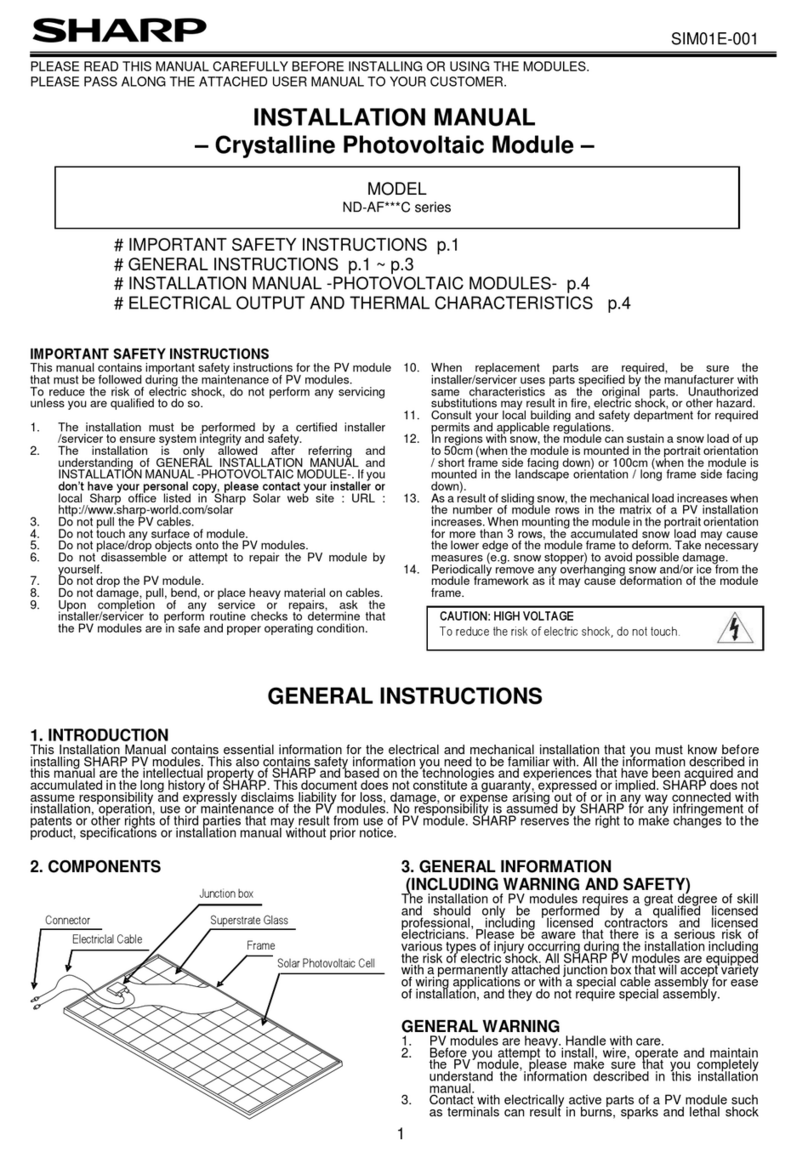
Sharp
Sharp ND-AF C Series installation manual

Thrane&Thrane
Thrane&Thrane EXPLORER 700 quick start guide
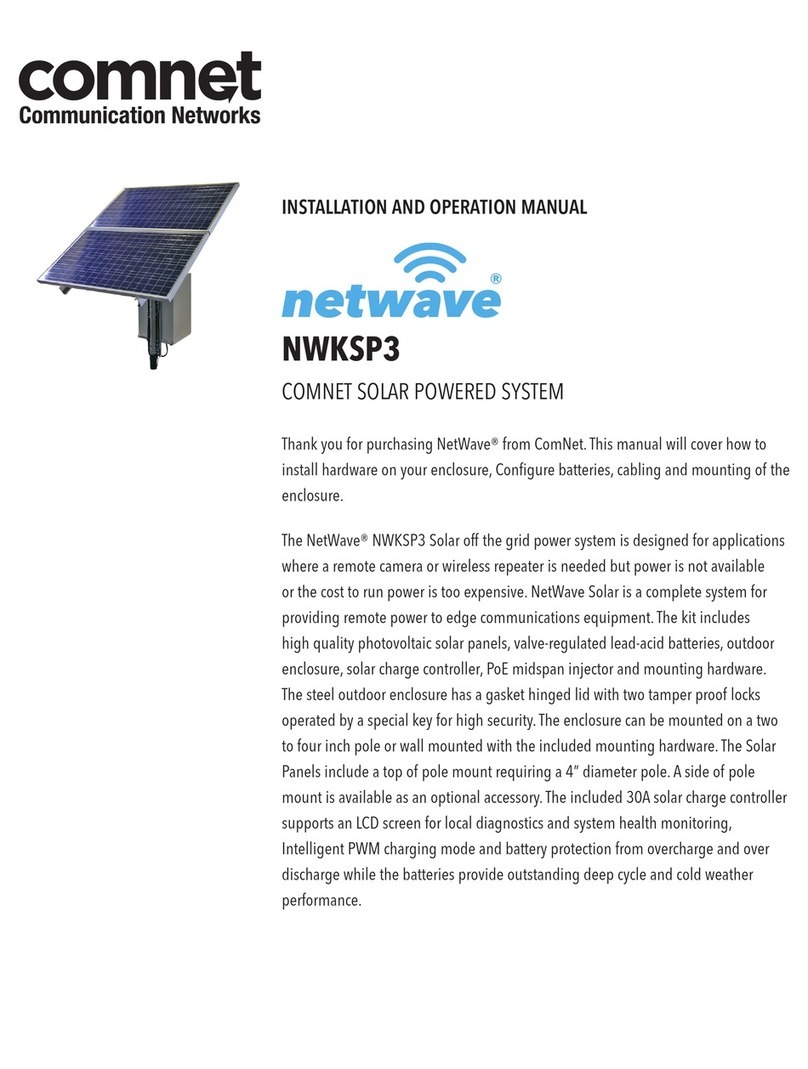
Comnet
Comnet netwave NWKSP3 Installation and operation manual
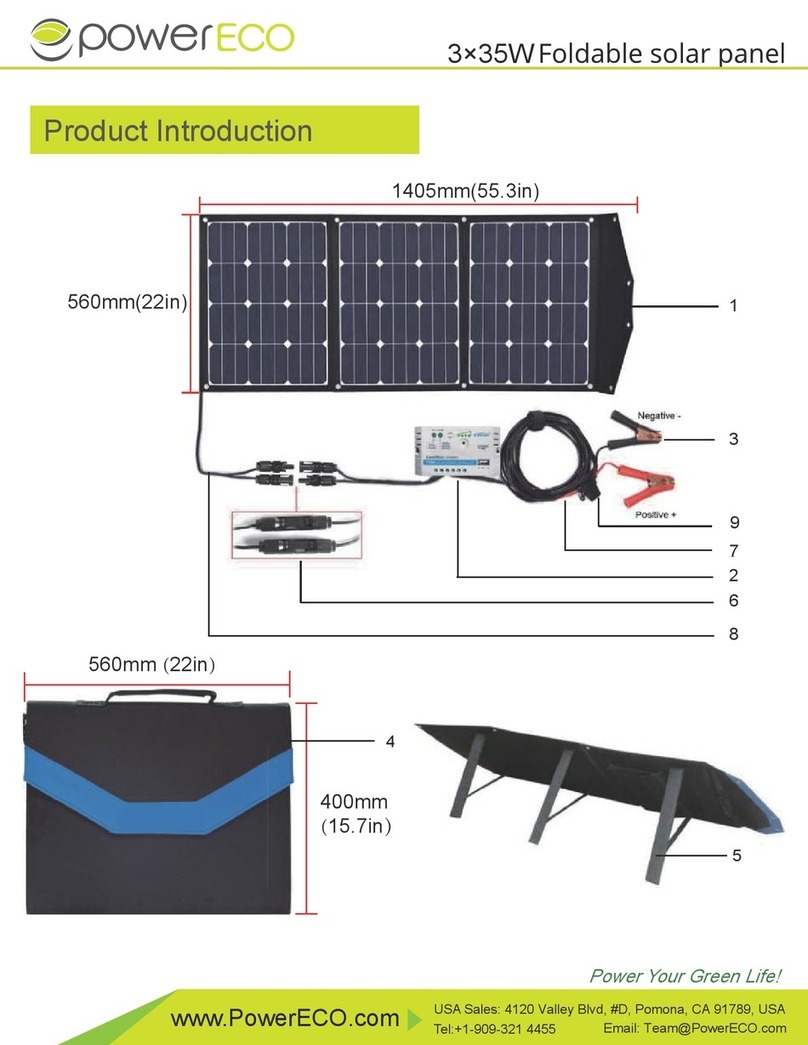
Powereco
Powereco PE-LTK-3x35W manual

Schumacher Electric
Schumacher Electric SP-5400 owner's manual
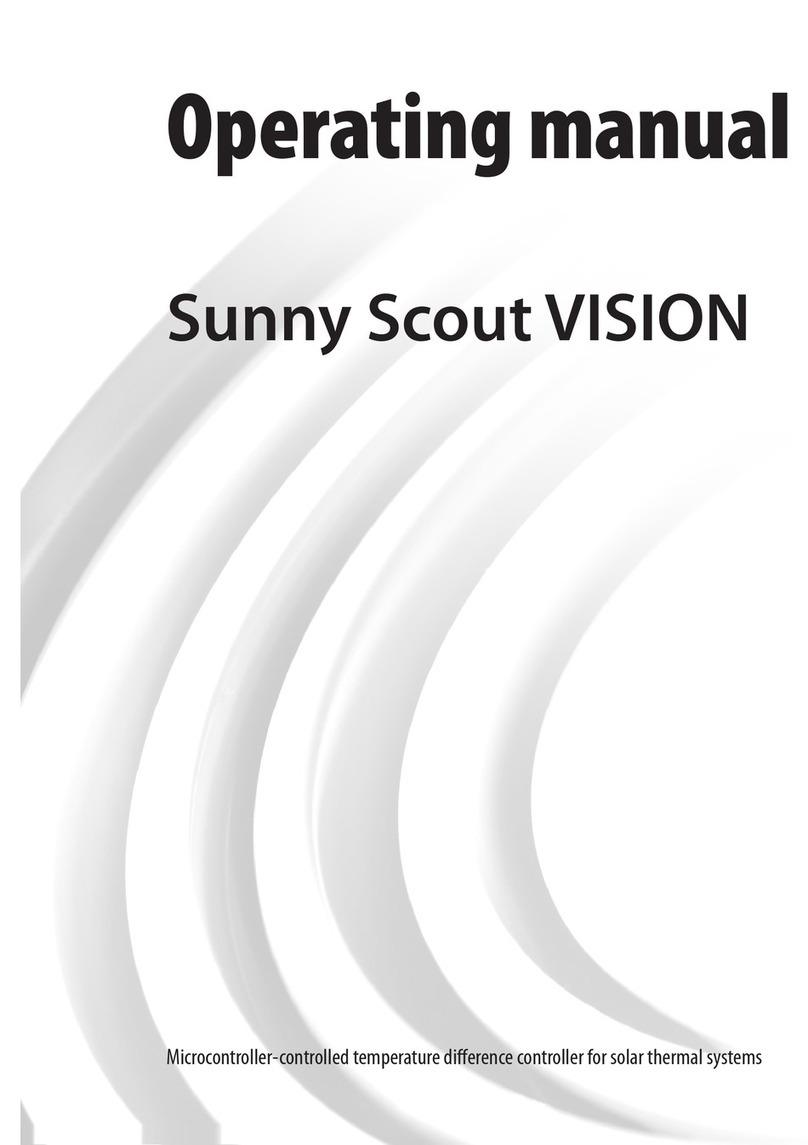
Sunny Scout
Sunny Scout VISION operating manual
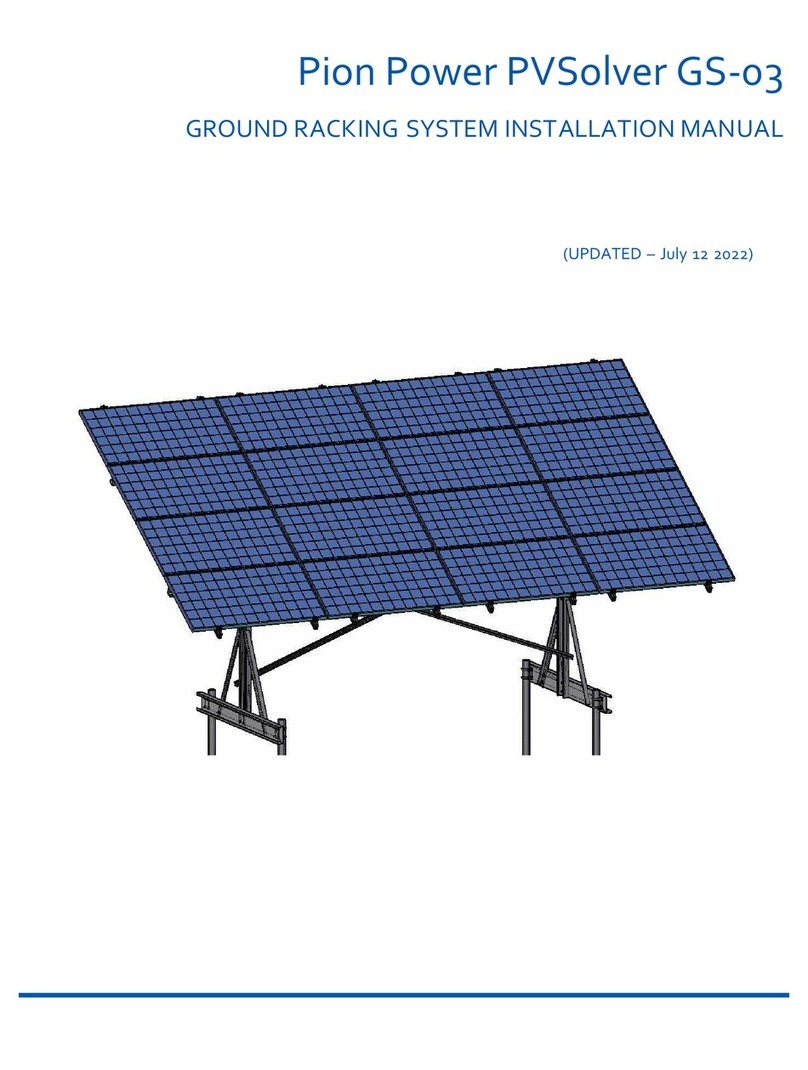
PION POWER
PION POWER PVSolver GS-03 installation manual

Chicago Electric
Chicago Electric 96350 25W Operation instructions

Lippert
Lippert GS-STAR-200W user manual
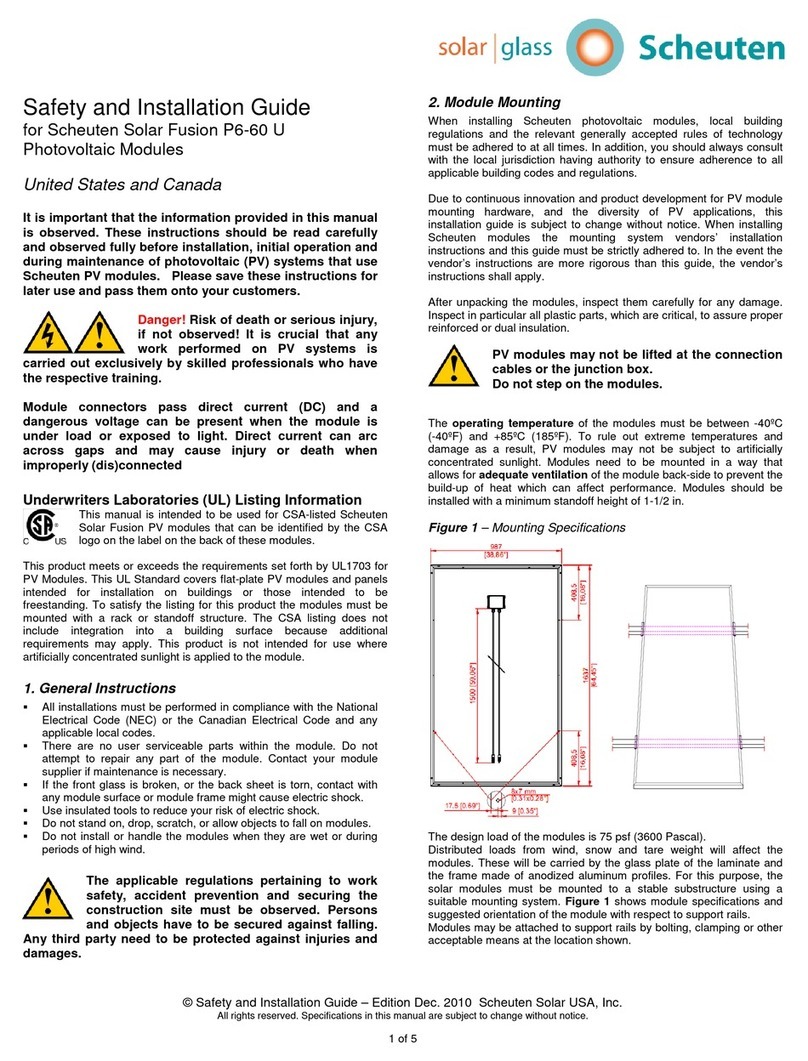
Scheuten
Scheuten Solar Fusion P6-60 U Safety and installation guide

Viessman
Viessman VITOSOL 100-F installation instructions
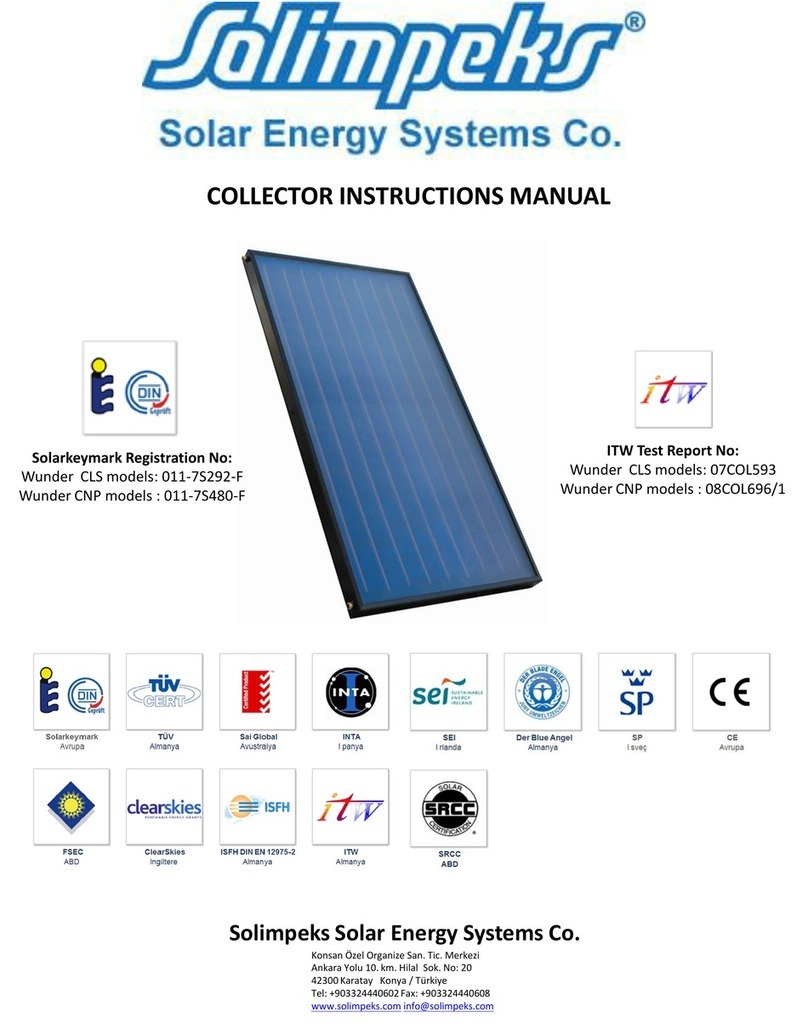
Solimpeks
Solimpeks Wunder CLS 2510 instruction manual



